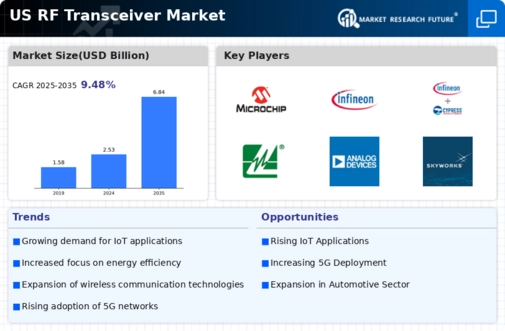Emergence of 5G Technology
The rollout of 5G technology is poised to revolutionize the rf transceiver market. As 5G networks become more widespread, the demand for RF transceivers that can support higher frequencies and increased data throughput is expected to rise. The rf transceiver market is adapting to this shift by developing innovative solutions that meet the requirements of 5G infrastructure. By 2025, the 5G sector is projected to generate revenues exceeding $200 billion, creating substantial opportunities for RF transceiver manufacturers. This technological advancement is likely to drive competition and innovation within the market, as companies strive to deliver cutting-edge products.
Growth of Smart City Initiatives
Smart city initiatives are significantly influencing the rf transceiver market. As urban areas in the US invest in smart infrastructure, the demand for RF transceivers that facilitate communication between devices increases. These initiatives often involve the deployment of sensors, smart meters, and connected vehicles, all of which require robust RF communication solutions. The rf transceiver market is expected to benefit from this trend, with estimates suggesting that investments in smart city technologies could exceed $500 billion by 2025. This growth presents opportunities for manufacturers to develop specialized RF transceivers that cater to the unique needs of smart city applications.
Advancements in Automotive Technologies
The automotive sector is undergoing a transformation with the integration of advanced technologies, which is driving the rf transceiver market. The rise of connected and autonomous vehicles necessitates sophisticated RF communication systems for vehicle-to-vehicle (V2V) and vehicle-to-infrastructure (V2I) communications. By 2025, the automotive segment is anticipated to account for a substantial share of the rf transceiver market, with projections indicating a growth rate of around 10%. The rf transceiver market is responding by developing transceivers that meet the stringent requirements for reliability and performance in automotive applications, thereby enhancing safety and efficiency.
Rising Demand for Wireless Communication
The increasing reliance on wireless communication technologies is a primary driver for the rf transceiver market. As industries such as telecommunications, automotive, and consumer electronics expand, the need for efficient and reliable RF transceivers grows. In 2025, the market is projected to reach approximately $10 billion, reflecting a compound annual growth rate (CAGR) of around 8%. This demand is fueled by the proliferation of mobile devices and the need for seamless connectivity. The rf transceiver market is adapting to these trends by innovating products that support higher data rates and improved performance, which are essential for modern applications.
Increased Investment in Defense and Aerospace
The defense and aerospace sectors are significant contributors to the rf transceiver market. With rising geopolitical tensions and the need for advanced communication systems, investments in military and aerospace applications are on the rise. The rf transceiver market is likely to see a surge in demand for high-performance RF transceivers that can operate in challenging environments. In 2025, defense spending in the US is projected to reach $800 billion, with a notable portion allocated to communication technologies. This trend indicates a robust market for RF transceivers designed for secure and reliable military communications.























Leave a Comment